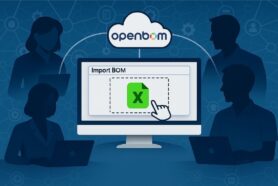
I haven’t had a chance to meet a manufacturing company that was not interested in cost analysis or cost management. Cost is always one of the most important factors in business and manufacturing is super critical.
In the manufacturing sector, precision in cost estimation and forecasting stands as a cornerstone for competitiveness and operational efficiency. These processes play a crucial role in Bill of Materials (BOM) management, inventory management, purchasing, and forecasting, directly impacting a company’s ability to manage resources effectively and maintain profitability.
The Importance of Accurate Cost Estimation and Forecasting
Accurate cost estimation ensures that manufacturers can determine the financial resources required for the production of products. It encompasses direct costs such as raw materials and labor, as well as indirect costs like overheads and utilities. Similarly, forecasting allows businesses to predict future demand, production costs, and revenue, facilitating informed decision-making and strategic planning.
There are many ways to make a forecasting of the cost and cost analysis. However, what I found often missed is the ability to find the most accurate data for engineering and manufacturing cost analysis.
The design information and data that are stored inside the CAD system are some of the most important elements of cost formulation. Without this accurate information, all your plans might not work out as you expect. But the design is very much disconnected and, at its best, engineers will be sending some kind of spreadsheets that later will be used for cost forecasting.
The integration of Computer-Aided Design (CAD) and SolidWorks data into these processes represents a significant leap forward, enabling businesses to achieve greater accuracy and efficiency. Let me talk about it today and show how OpenBOM can be your best helper.
Leveraging CAD (eg. SolidWorks) for Enhanced Accuracy
CAD such as SolidWorks and many other systems are powerful tools used extensively in the design phase of product development. They offer detailed information about a product, from geometrical dimensions to material specifications. Getting this information is extremely beneficial for cost estimating and forecasting. By extracting and analyzing this data, manufacturers can significantly enhance the accuracy of their cost estimations and forecasting.
OpenBOM is fully integrated with CAD (eg. Solidworks) systems and allows users to extract the data. OpenBOM is immersed within the CAD environment and allows one to get information from its first data source – calculate quantities of the shelf parts, and make material assessments needed for custom-made parts (eg. sheet metal).
Check the article 5 Things Every SOLIDWORKS User Must Try To Do With OpenBOM, which will give you a great perspective on how OpenBOM captures the data.
I didn’t see any manufacturing company that will stay neutral to the ability to automatically create a cost rollup in multi-level cost rollup based on the data imported from the finance or ERP environment. It is a priceless function and it can save you a ton of time. Check the following documentation page in the OpenBOM Training Library to learn more about the rollup function.
Inventory and BOM Management
The integration of CAD/SolidWorks data streamlines the creation and management of BOMs, a critical component in inventory management. This integration allows for automated BOM generation, reducing errors and ensuring that all materials and components are accurately accounted for from the design phase. It also enables real-time updates to BOMs as designs change, ensuring that inventory management systems are always in sync with current product specifications.
Purchasing and Supplier Negotiation
With accurate BOMs derived from CAD/SolidWorks data, procurement teams can more effectively negotiate with suppliers. Knowing exactly what materials and in what quantities are needed ahead of time allows for bulk purchasing and early supplier involvement, potentially leading to cost savings and better supplier relationships.
OpenBOM gives you an easy way to manage inventory levels, which can be a good solution for new product development prototyping and small batch production. Learn more about it – Production Planning and Procurement.
Forecasting
Forecasting benefits from the integration of CAD (eg. SolidWorks) data by providing a more detailed basis for predicting future production needs. By understanding the specific materials and components required for upcoming products, companies can better forecast demand for raw materials, manage supplier relationships, and plan production schedules to meet anticipated demand.
Conclusion
The integration of CAD (eg. SolidWorks) data into cost estimation and forecasting processes represents a significant advancement in managing manufacturing processes. Earlier cost estimation is extremely important.
By leveraging detailed design data, companies can achieve greater accuracy in their estimations and forecasts, leading to improved inventory and BOM management, more effective purchasing strategies, and better-informed forecasting. Despite the challenges, the potential benefits in terms of cost savings, efficiency improvements, and competitive advantage make this an investment worth considering for any forward-thinking manufacturing business.
Register for free and check how OpenBOM can help you today.
Best, Oleg
Join our newsletter to receive a weekly portion of news, articles, and tips about OpenBOM and our community.










